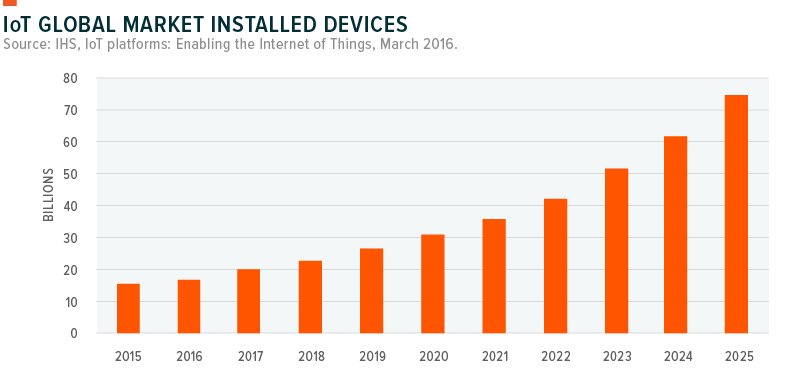Around the world, devices are getting smarter and they are more connected than ever before.
What Is The Internet of Things?
The Internet of Things (IoT) describes a growing network of connected “things” that contain sensors, chips, processors and the ability to interact with other devices on a network. While we have accepted that computers, printers, and smart phones have this capacity – we are now starting to see televisions, automobiles, and even electrical grids which can send and receive data or be controlled remotely.

In 2016, it is estimated that nearly 18 billion devices were capable of sending or receiving data. By 2025, expectations are that more 75 billion devices will be connected.1
IoT In Our Daily Lives
The IoT enables household devices like refrigerators, washers, thermostats, and lighting to be controlled by a smartphone from virtually anywhere. These devices can relay the current temperature within the home from a thermostat, or that their refrigerator is out of milk. Analysts expect the home market for smart devices to grow from $47 billion in 2015 to $122 billion by 2022.2
Away from the home, wearable devices which track body movement and caloric usage are already becoming mainstream. The global market for wearable devices witnessed year-on-year growth of 38% in 2016 and has been one of the early drivers within the IoT space.3
The commute to work or school is a natural place for smart devices, and by 2025 expectations are that 250 million vehicles will be connected to the internet. This advancement will underpin the movement toward self-driving vehicles, as it provides the infrastructure needed for vehicles to communicate with each other and mapping software in real-time.
IoT At Work
Office buildings will be able to monitor their own wear and tear and factories will predict maintenance needs, improving health and safety, and overall efficiency. Manufacturing is expected to be one of the largest contributors to the overall growth of IoT, with global revenue opportunities for IoT within manufacturing growing from $472 billion in 2014 to a projected $913 billion by 2018.4
IoT and Infrastructure
Utility grids will be able to connect to the internet and communicate with energy providers and end-users in real-time. This information will be used to distribute energy more efficiently across the grid or allow end-users to better gauge power usage during peak hours.
The next iteration is an expansion to smart cities – traffic lights, trash cans, water and gas lines, all connected and sending service or status updates. This data transmission will help improve traffic and safety, while reducing maintenance costs. It is estimated that municipalities worldwide will increase their spending on IoT systems more than threefold, from $36 billion in 2014 to $133 billion in 2019.5
Future Growth Expectations
According to Gartner, Inc, more than 50% of new business processes will contain devices connected to the IoT.6 All things told, the total economic impact of IoT, including consumer surplus, is estimated to be between $3.9 and $11.1 trillion in 2025.7
Which Sectors Are Positioned To Benefit From This Growth?
There are three primary industries which are situated to potentially benefit from this rapidly expanding theme:
- Connected Device Manufacturers: Creators of wearables, smart meters, and appliances.
- Network Providers or Services: IoT depends on fast, secure, and reliable networks to transmit information from sensors to data processors and control systems.
- Semi-Conductor Manufacturers: IoT is expected to significantly increase demand for microcontrollers, sensors, communication devices and flash memory.
In September 2016 we launched the Global X Internet of Things ETF (SNSR), which seeks to invest in companies that stand to potentially benefit from the rise of the Internet of Things.8 This includes the development and manufacturing of semiconductors and sensors, integrated products and solutions, and applications serving smart grids, smart homes, connected cars, and the industrial internet.
The Global X Internet of Things ETF (SNSR) enables investors to access a potential high growth theme through companies at the leading edge of IoT, an approach which transcends classic sector, industry and geographic regions to target this emerging theme. In a single trade, SNSR delivers access to dozens of companies with high exposure to emerging IoT technology.
 Global X Research Team
Global X Research Team